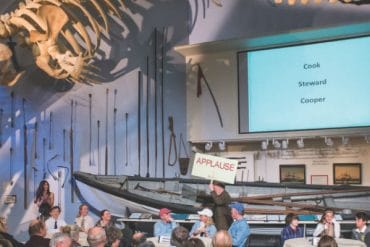 From a bird’s-eye view, Nantucket looks much like it did over a hundred years ago, with houses and properties sprinkled amidst sprawling forests, beaches, moors, and wetlands. But this didn’t happen naturally. For fifty years, The Nantucket Conservation Foundation has been purchasing land to keep undeveloped and pristine. With nearly nine thousand acres now under its protection, some may wonder what’s left for the foundation to buy?
From a bird’s-eye view, Nantucket looks much like it did over a hundred years ago, with houses and properties sprinkled amidst sprawling forests, beaches, moors, and wetlands. But this didn’t happen naturally. For fifty years, The Nantucket Conservation Foundation has been purchasing land to keep undeveloped and pristine. With nearly nine thousand acres now under its protection, some may wonder what’s left for the foundation to buy?
Exactly fifty years after it was founded, the Nantucket Conservation Foundation added a massive plot of land to its already sprawling portfolio of island property. For a price tag of $19 million, the foundation purchased Norwood Farm last December. The 207 acres located in the middle moors is the last major undeveloped tract of land on the island, and the purchase may just mark the end of giant land acquisitions on Nantucket. So what will the next fifty years hold for Nantucket’s largest landowner?
“We have to take care of the land we own,” says Jim Lentowski, who has been NCF’s executive director since 1971, “and we take being stewards of the land very seriously.” Going forward, the foundation will focus more on management, science, education and membership in the organization rather than primarily on land acquisition. That’s not to say that buying more land is off their agenda. At press time, the foundation had its eye on the property surrounding the Loran Tower owned by the Coast Guard in ‘Sconset, and the Head of Plains property in Madaket where the town is considering putting a wastewater treatment plant. For now, the management of their nearly nine thousand acres is the foundation’s top priority.
It’s hard to picture Nantucket without the Conservation Foundation. Imagine looking out over Madequecham Valley and having it covered in condominiums. Or if the Haulover passage to Coatue was off limits to the public. Thankfully, the places where many Nantucketers played as children and later retreated to for solitude as teenagers and adults are preserved in perpetuity. Many love jogging or walking their dogs at the foundation’s Sanford Farm and Tupency Links, while others cruise the middle moors by bicycle under the moonlight where there is a spectacular view of the island from Altar Rock.
Even if you never step foot on the foundation’s property, it’s impossible to come to Nantucket without seeing the serenity of the landscapes in their care. “Nantucket has the feeling of not changing and people appreciate that,” says Lentowski. “Open space has protected the quality of life here. Without open space, people might not come back to Nantucket.” Lentowski was hired as the foundation’s first paid employee back in 1971. Four hundred and fifty land acquisitions later, he’s a walking Wikipedia on the conservation history of Nantucket. The first property purchased by the foundation was the bird sanctuary on North Beach Street near Jetties Beach, which was less than one acre. With the outspoken trustees, many of whom were donating land themselves, the acreage started growing. It’s unusual for a private conservation organization in the United States to own land, let alone 30 percent of a county. In this regard, the NCF is a national leader.
The year Lentwoski was hired, the foundation made its first major land purchase: 625 acres known as Ram’s Pasture. This piece of land, like the many that came thereafter, was purchased by the foundation because of its dearness to the community and potential for development. As Lentwoski explains, “We targeted land that was enjoyed by the public and was taken for granted to the point where people thought it was in public ownership. But in reality it was under private ownership. And the time had come for that private ownership to be converted to cash.” The foundation paid $1,000 per acre to keep Ram’s Pasture open to the community, and it remains public to this day.
In 1992, the foundation took on a new commitment to scientific research and land stewardship by hiring Karen Beattie, a rare species ecologist. Her work protecting nesting shore birds continues today, as well as protecting rare species through controlled burns and clearings. Under Beattie’s tenure, the foundation collaborates with the University of Massachusetts, The Biodiversity Initiative, individual researchers and many island nonprofits to conduct research that in turn influences land management decisions.
This is undoubtedly an exciting time for the Nantucket Conservation Foundation. The grueling legwork of amassing properties is over, with the exception of a few small but strategic parcels. The foundation can now focus more on its partnerships with other programs and organizations, like the newly returned U- Mass Boston’s Environmental Semester Program, as well as collaboration with its members. Meanwhile the foundation will continue to search out the best land management strategies for the times, considering climactic changes as well as social ones. It’s difficult to imagine what the island’s landscape would look like without the Nantucket Conservation Foundation. Thankfully, we don’t have to.





